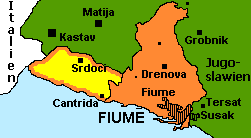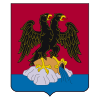Fiume Free State
|
Free State of Fiume Stato libero di Fiume (Italian) Slobodna Država Rijeka (Croatian) 1920–1924 |
|||||
|---|---|---|---|---|---|
|
|||||
|
|||||
| Motto | Indeficienter | ||||
| Constitution | unknown | ||||
| Official language |
Italian Croatian |
||||
| Capital | Fiume | ||||
| Form of government | republic | ||||
| Form of government | Parliamentary democracy | ||||
| Head of State and Government |
President Riccardo Zanella (1921–1922) Giovanni Giuriati (1922–1923) Italian military governor Gaetano Giardino (1923–1924) |
||||
| surface | 28 km² (1922) | ||||
| Residents | 52,000 (1922) | ||||
| Population density | 1857 inhabitants / km² | ||||
| currency |
Austrian crown Italian lira |
||||
| founding | November 12, 1920 ( Rapallo Border Treaty ) |
||||
| resolution | January 27, 1924 ( Treaty of Rome ) |
||||
| National anthem | unknown | ||||
| Time zone | UTC + 1 CET | ||||

|
|||||
The Free State of Fiume , also Free State of Rijeka ( Italian : Stato libero di Fiume , Croatian : Slobodna Država Rijeka ), was an independent Free State around the city of Fiume, which today belongs to Croatia as Rijeka and existed from 1920 to 1924. The national territory comprised the city of Fiume and the northern environs as well as a corridor connecting it with Italy , a total of 28 km².
prehistory
Fiume was in 1719 by a decree of the Roman-German Emperor Charles VI. self-employed for the first time as a free port. In 1779, during the reign of Empress Maria Theresa , the city received the status corpus separatum under the name Fiume város . The city lost its independence in 1848 when it was captured by Ban Josip Jelačić , but was returned to corpus separatum status in 1868 as part of the Kingdom of Hungary . Until the middle of the 19th century, the city was predominantly populated by Croats, but the Hungarian government encouraged the influx of Italians, who had grown into the largest ethnic group at the end of the 19th century.
In addition to Croats and Italians, Germans, Slovenes, Hungarians and residents of other nationalities also lived in the city, in proportions of the total population that changed from census to census. This status of a multinational city was considered something special and created an identity of its own for the majority of the population. The official languages were Hungarian and German , business correspondence was conducted in Italian, while most families spoke the Croatian dialect Čakavisch or an Italian dialect called Fiuman .
After the First World War and the collapse of Austria-Hungary , the question of the status of Fiume became an international problem. At the height of the conflict between the Kingdom of Serbs, Croats and Slovenes and the Kingdom of Italy , the victorious powers spoke out in favor of the creation of an independent buffer state. The American President Woodrow Wilson became a mediator in the Yugoslav-Italian dispute over the future of the city. He suggested that Fiume should become independent and possibly a future seat of the League of Nations .
The dispute between the South Slav and Italian National Committees led to lawless conditions and eventually to the landing of British and French troops who took control of the city. The still unresolved political situation of the Italian was "pre-fascist" nationalists and poet Gabriele D'Annunzio used the Fiume with his Arditi mentioned guerrillas occupied on September 12 1919th After a 15-month period of social chaos and a year after the failure of negotiations with the Italian government, D'Annunzio proclaimed the Italian reign on the Quarnero .
History of the Free State
On November 12, 1920, the Kingdom of Italy and the Kingdom of Serbs, Croats and Slovenes signed the Rapallo Border Treaty , in which both parties agreed to recognize a free and independent Free State of Fiume and pledged to respect its independence forever. With this act the “Free State of Fiume” was created, which as an independent state was to exist de facto for about one year and de jure four years. The new state was immediately recognized by the United States , France and Great Britain . D'Annunzio refused the contract and was expelled from the city in the "Bloody Christmas" from December 24th to 30th, 1920 by regular troops of the Italian army .
In April 1921, the voters in Fiume confirmed the plan of the Italian Prime Minister to found the Free State and an Italo-Fiuman-Yugoslav consortium to manage the port of Fiume. The Autonomists and the pro-Italian National Bloc won the first parliamentary elections. The Autonomist Party, supported by the majority of the Croatian population, received 6,558 votes, while the National Bloc, made up of fascists, liberals and democrats, received 3,443 votes. The leader of the autonomists Riccardo Zanella became president. On March 3, 1922, Italian fascists took power with a coup d'état , and the legal government fled to Kraljevica .
In January 1924, the Kingdom of Serbs, Croats and Slovenes voted in the Treaty of Rome of annexation to the city by Italy, which was completed on 16 March. The Free State's government-in-exile declared the occupation illegal and invalid under international law, and continued its activities.
Aftermath
With the capitulation of Italy in World War II , the Rijeka question became topical again. In 1944 a group of citizens published the "Liburnia Memorandum", in which the formation of a federal state from the three districts of Rijeka, Sušak and Bistrica was proposed. The islands of Krk , Cres and Lošinj should join the condominium . President Zanella from the government in exile also advocated the restoration of the Free State.
The troops of the Yugoslav Liberation Army , who liberated the city from German occupation on May 3, 1945 , thwarted this plan. With the Peace Treaty of Paris in 1947 , Rijeka and Istria officially became part of the Federal People's Republic of Yugoslavia .
The coat of arms of Rijeka, the two-necked double-headed eagle , which was banned during both fascist and communist rule, was only reintroduced in 1998.
literature
- Raoul Puppo and Pablo Todero (eds.): Fiume, D'Annunzio e la crisi dello Stato liberale in Italia , University of Trieste 2010
- Kersten Knipp: The Fascist Commune. Gabriele D'Annunzio, the Republic of Fiume and the extremes of the 20th century. wbg Theiss, Darmstadt 2018, ISBN 978-3-8062-3914-0 .
- Marijana Erstic / Daniel Winkler: Rijeka / Fiume. Italy and Croatia (= Zibaldone. Magazine for contemporary Italian culture. No. 68, 2019). Stauffenburg, Tübingen 2020, ISBN 978-3-95809-711-7 .
Individual evidence
- ^ Neil Smith: American Empire Roosevelt's Geographer and the Prelude to Globalization . University of California Press, Berkeley and Los Angeles 2003, ISBN 978-0-520-23027-9 , pp. 167 ( preview in Google Book search).
- ↑ Iva Lukezic: Two Popular Languages of the city of Rijeka . In: Fluminensia No. 1 . Filozofski Faculty, 1993, ISSN 0353-4642 , p. 25–38 ( summary point 4 (English) ; ( original article )). Summary point 4 (English)]; ([http://hrcak.srce.hr/133026 Original article ( Memento of the original dated December 16, 2010 in the Internet Archive ) Info: The archive link was automatically inserted and not yet checked. Please check the original and archive link according to the instructions and then remove this notice.
- ↑ Harold G. Nicolson: Peacemaking, 1919 . Simon Publications LLC, Washington 2001, ISBN 978-1-931541-54-1 , pp. 157 ( preview in Google Book search).
- ↑ Ljubinka Toševa-Karpowicz: D'Annunzio u Rijeci: mitovi, politika i uloga masonerije , Izdavački centar Sušak, Biblioteka Dokumenti, Rijeka 2007, p. 23; However, the author does not name a source.
- ^ Elihu Lauterpacht: International Law Reports . Cambridge University Press, Cambridge 1945, ISBN 978-0-521-46353-9 , pp. 430 .
- ^ Adrian Webb: The Routledge Companion to Central and Eastern Europe Since 1919 . Routledge, New York 2008, ISBN 978-1-134-06521-9 , pp. 53 ( Preview in Google Book Search).

